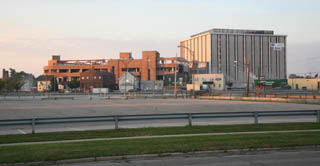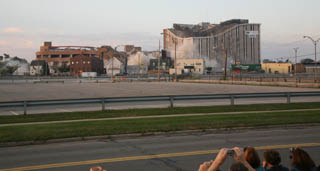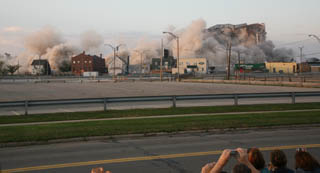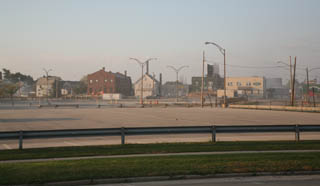
Photographs and text by Walter Horylev The sun came out from behind the clouds around 7:20 a.m. Saturday, October 6 and bathed Buildings 65 and 69 in a warm light, comforting, like a convict’s last meal. The huge crowd, many in Kodak parking lot 42, and many spread around the area to the north and west, well away from the two buildings, were assembled to watch the impending implosion of the structures. Alumni from the two buildings exchanged greetings and commiseration. Cameras were everywhere, mostly digital; an ironic recording device to preserve memories of two buildings where so much was done to develop new films and papers and where so many pictures were produced for amateur and professional photographers. There was a buzz going around as people patiently waited and vied for good positions to photograph the event. I finally found a good vantage point just behind two TV cameramen and also waited. That time was well spent as I recalled pleasant and exciting moments in the 20 years, beginning in 1954, I spent in those two buildings: the gab fests during the 20 minute coffee breaks, (morning and afternoon) ... the huge drying drums in CP&P where an endless stream of colorful customer prints rolled off the surface accompanied by the pungent odor of formaldehyde used in the final rinse of the process to harden the emulsion ... the Christmas carols we sang in the cafeteria ... the endless series of meetings necessary to develop new and improved products ... the comprehensive testing and comparison work to prove we were successful ... the camaraderie of the “Off Beats,” a large orchestral group composed mostly of Photo Tech employees, who played for peanuts and enjoyed every minute of it ... the friendships formed in those two buildings that carried on through my 33 year career at Kodak ... the laughs from an envelope addressed to me (when the organization was called Color Technology): Att. Walter Horgler, Colon Technology ... the development of young engineers into technically-oriented management positions throughout the company ... the first engineer I met on my first day of work was Colby Chandler, who, in time, became manager of CP&P and eventually CEO of Kodak ... the time our Photo Tech basketball team won the league title and our personnel director took us to B-28 for lunch ... the Friday evening CP&P golf league that ran for around 50 years at Lake Shore Country Club and the scramble to get to the clubhouse and have an early starting time ... the construction of B-69 which we could see out of our third floor window in B-65 (including explosions under mats to form holes for the foundation) ... the flood in B-69 soon after it opened, when the plastic water pipe connections came apart ... the agony when a Photo Tech engineer died in that famous plane crash in Chicago ages ago ... and, I’m sure, so many other memories shared by others after I left for an assignment in another building. Now it was 7:30 a.m., the appointed time for the implosion. We were kept waiting for about another 10 minutes, watching men hosing down both buildings, with an impressive wall of water spray clearly visible to the east of B-65. Then a siren sounded and, soon after, we heard a series of loud booms, more than 10, the kind that reverberate in your stomach. After the last explosion it seemed like the two buildings were spared, but, no, in a second they started to collapse, B-69’s left front top slowly falling towards us, (the northeast). The crowd let out various sounds of “awe.” In a matter of seconds the buildings disappeared in clouds of dust which originated at various spots along the base of the buildings; the clouds grew higher and higher and, aided by a south wind, soon approached the large crowd in the parking lot. Everybody started to quickly move towards their vehicles but they were soon enveloped in a heavy cloud of brown-grey dust, a dust that had a slightly acrid taste and smell. It was awful. It reminded me of a movie version of a sand storm and many people, who were wise enough to foresee this and brought face masks, put the masks on; I resorted to a folded handkerchief. Visibility was poor for about 10 minutes but it didn’t prevent the dust-covered vehicles from slowly lumbering out of the parking lot and the wind finally cleared most of the dust from the air in that location. The spaces that had contained two buildings became clearly visible about 15 minutes after the implosions. Somehow the skyline looked forlorn, missing the rectangular version of the Pylon and the Hemisphere of that old World’s Fair in NYC. It was great “show,” but, personally, I will miss these old “friends” of mine; they were my home away from home. At least I was there to say: “Goodbye.” © October 14, 2007 - Westside News Inc. |



